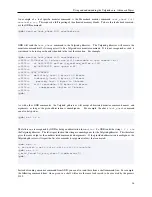
Using and understanding the Valgrind core: Advanced Topics
adb forward tcp:1234 tcp:1234
gdb prog
(gdb) target remote :1234
GDB will use a local tcp/ip connection to connect to the Android adb forwarder. Adb will establish a relay connection
between the host system and the Android target system. Be sure to use the GDB delivered in the Android NDK system
(typically, arm-linux-androideabi-gdb), as the host GDB is probably not able to debug Android arm applications. Note
that the local port nr (used by GDB) must not necessarily be equal to the port number used by vgdb: adb can forward
tcp/ip between different port numbers.
In the current release, the GDB server is not enabled by default for Android, due to problems in establishing a suitable
directory in which Valgrind can create the necessary FIFOs (named pipes) for communication purposes. You can stil
try to use the GDB server, but you will need to explicitly enable it using the flag
--vgdb=yes
or
--vgdb=full
.
Additionally, you will need to select a temporary directory which is (a) writable by Valgrind, and (b) supports FIFOs.
This is the main difficult point. Often,
/sdcard
satisfies requirement (a), but fails for (b) because it is a VFAT file
system and VFAT does not support pipes. Possibilities you could try are
/data/local
,
/data/local/Inst
(if
you installed Valgrind there), or
/data/data/name.of.my.app
, if you are running a specific application and it
has its own directory of that form. This last possibility may have the highest probability of success.
You can specify the temporary directory to use either via the
--with-tmpdir=
configure time flag, or by setting
environment variable TMPDIR when running Valgrind (on the Android device, not on the Android NDK development
host). Another alternative is to specify the directory for the FIFOs using the
--vgdb-prefix=
Valgrind command
line option.
We hope to have a better story for temporary directory handling on Android in the future. The difficulty is that, unlike
in standard Unixes, there is no single temporary file directory that reliably works across all devices and scenarios.
3.2.5. Monitor command handling by the Valgrind
gdbserver
The Valgrind gdbserver provides additional Valgrind-specific functionality via "monitor commands". Such monitor
commands can be sent from the GDB command line or from the shell command line. See
Valgrind monitor commands
for the list of the Valgrind core monitor commands available regardless of the Valgrind tool selected.
The following tools provide tool-specific monitor commands:
•
Memcheck Monitor Commands
•
Callgrind Monitor Commands
•
Massif Monitor Commands
35
Содержание BBV
Страница 176: ...Valgrind FAQ Release 3 8 0 10 August 2012 Copyright 2000 2012 Valgrind Developers Email valgrind valgrind org ...
Страница 177: ...Valgrind FAQ Table of Contents Valgrind Frequently Asked Questions 1 ii ...
Страница 302: ...README mips based on newer GCC versions if possible 95 ...
Страница 303: ...GNU Licenses ...
Страница 304: ...GNU Licenses Table of Contents 1 The GNU General Public License 1 2 The GNU Free Documentation License 8 ii ...
















































